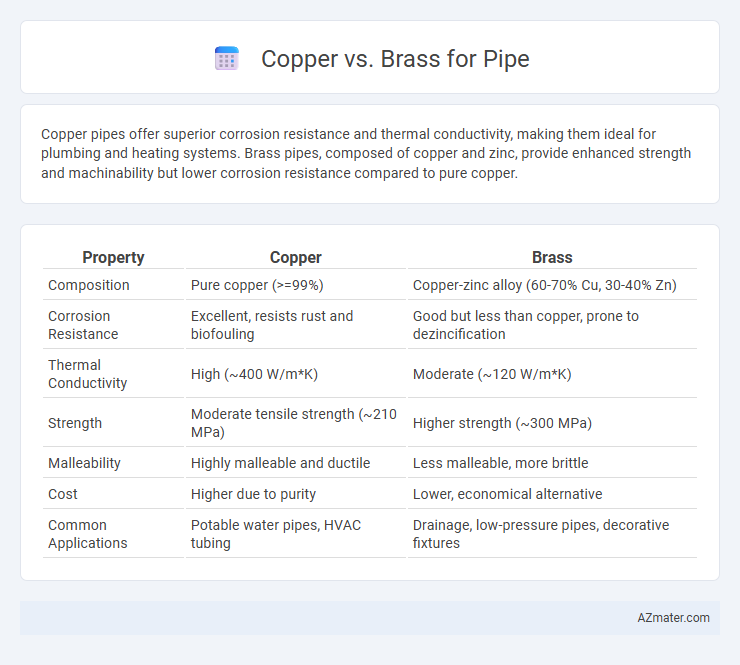Copper pipes offer superior corrosion resistance and thermal conductivity, making them ideal for plumbing and heating systems. Brass pipes, composed of copper and zinc, provide enhanced strength and machinability but lower corrosion resistance compared to pure copper.
Table of Comparison
| Property | Copper | Brass |
|---|---|---|
| Composition | Pure copper (>=99%) | Copper-zinc alloy (60-70% Cu, 30-40% Zn) |
| Corrosion Resistance | Excellent, resists rust and biofouling | Good but less than copper, prone to dezincification |
| Thermal Conductivity | High (~400 W/m*K) | Moderate (~120 W/m*K) |
| Strength | Moderate tensile strength (~210 MPa) | Higher strength (~300 MPa) |
| Malleability | Highly malleable and ductile | Less malleable, more brittle |
| Cost | Higher due to purity | Lower, economical alternative |
| Common Applications | Potable water pipes, HVAC tubing | Drainage, low-pressure pipes, decorative fixtures |
Introduction: Copper vs Brass Pipes
Copper pipes offer excellent corrosion resistance, high thermal conductivity, and antimicrobial properties, making them ideal for plumbing and heating systems. Brass pipes, composed of copper and zinc, provide greater strength and durability with improved resistance to wear and corrosion in high-pressure applications. Both materials are widely used in pipe manufacturing, but copper excels in thermal performance, while brass is favored for its mechanical robustness.
Composition and Properties of Copper
Copper pipes consist primarily of copper, a ductile metal with excellent thermal and electrical conductivity, corrosion resistance, and antimicrobial properties. The composition typically includes over 99% pure copper, often alloyed with trace amounts of zinc, tin, or lead to enhance strength and machinability. Copper exhibits higher durability and flexibility compared to brass, enabling it to withstand high pressure and temperature variations in plumbing applications.
Composition and Properties of Brass
Brass is an alloy primarily composed of copper and zinc, with copper content typically ranging from 55% to 95%, which significantly influences its corrosion resistance and machinability compared to pure copper pipes. The addition of zinc enhances brass's strength, hardness, and resistance to dezincification, making it a preferred choice for Durability in plumbing applications. Brass pipes also exhibit excellent thermal conductivity and antimicrobial properties, benefiting water supply systems by reducing bacterial growth and maintaining water quality.
Durability and Corrosion Resistance
Copper pipes offer superior durability due to their ability to withstand high temperatures and pressures, making them ideal for long-term plumbing applications. Brass, an alloy of copper and zinc, provides enhanced corrosion resistance, especially against dezincification in water systems, extending the lifespan of pipes in corrosive environments. Both materials resist rust, but copper typically outperforms brass in maintaining structural integrity under varied conditions.
Cost Comparison: Copper vs Brass
Copper pipes typically cost between $2 to $4 per foot, while brass pipes range from $3 to $6 per foot, making copper generally more affordable for plumbing applications. The higher cost of brass is due to its alloy composition combining copper and zinc, offering enhanced corrosion resistance and durability but at a premium price. When considering budget constraints, copper provides a cost-effective solution, whereas brass is often chosen for specialized uses where longevity and resistance justify the investment.
Ease of Installation and Flexibility
Copper pipes offer superior ease of installation due to their lightweight nature and ability to be easily cut and soldered, making them ideal for complex plumbing layouts requiring precise fittings. Brass pipes provide excellent flexibility, allowing for bending without cracking, which reduces the need for additional connectors and simplifies routing in tight spaces. Both materials resist corrosion, but copper's straightforward joining methods generally make it preferred for quick and reliable installations.
Applications and Common Uses
Copper pipes are widely used in plumbing, heating, and cooling systems due to their excellent corrosion resistance and antimicrobial properties, making them ideal for potable water delivery and HVAC applications. Brass pipes, composed of copper and zinc, are favored for decorative fixtures, valve bodies, and fittings because of their higher strength, machinability, and resistance to dezincification. Both materials find applications in marine environments, but copper is preferred for water supply lines, while brass is commonly used in mechanical components and specialty piping where durability and aesthetic appeal are critical.
Health and Safety Considerations
Copper pipes offer superior antimicrobial properties, reducing the risk of bacterial growth and ensuring safer drinking water. Brass pipes, containing varying amounts of zinc and sometimes lead, may pose health risks due to potential metal leaching, particularly in older or low-quality fittings. Regulatory standards often favor copper for potable water applications to minimize contamination and promote long-term health safety.
Maintenance and Lifespan
Copper pipes offer superior corrosion resistance and require minimal maintenance, often lasting over 50 years in residential plumbing systems. Brass pipes, while durable and slightly more resistant to dezincification, may need periodic inspection to prevent mineral buildup and typically have a lifespan of 40 to 45 years. Regular cleaning and monitoring of water quality can further extend the functionality and durability of both copper and brass piping materials.
Choosing the Right Material for Your Project
Copper pipes offer superior corrosion resistance and thermal conductivity, making them ideal for water supply and heating systems. Brass pipes, composed of copper and zinc, provide enhanced strength and durability with better resistance to wear, suitable for plumbing applications requiring higher mechanical stress. Select copper for applications demanding high purity and antimicrobial properties; choose brass when tougher mechanical endurance and ease of machining are priorities.

Infographic: Copper vs Brass for Pipe
 azmater.com
azmater.com